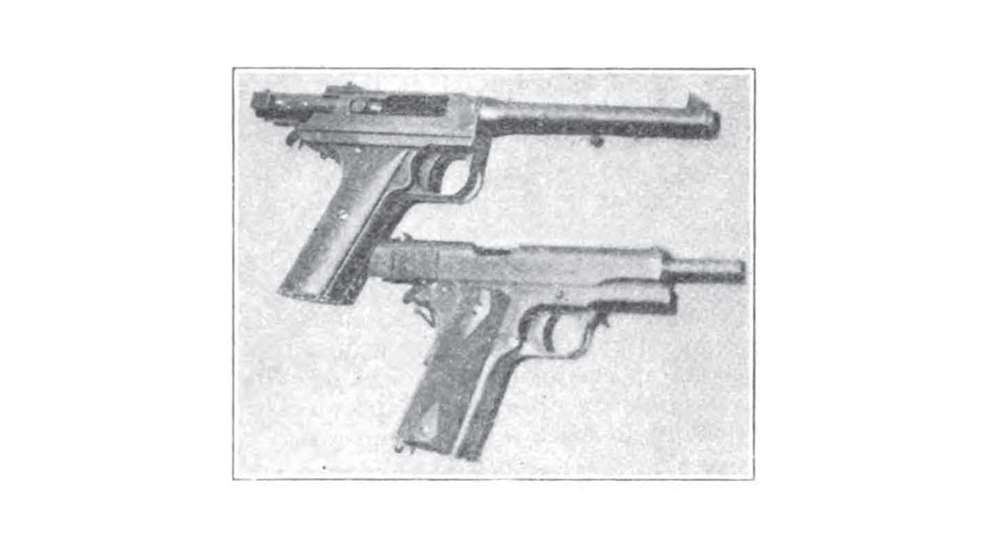
This article appeared originally in the October, 25 1919 issue of Arms And The Man, predecessor to today's American Rifleman. To subscribe to the monthly magazine, visit NRA’s membership page.
While the U.S. Army's search for an effective semi-automatic pistol during the 1907 trials ended with selection of John Moses Browning's M1911 pistol, it did expose the world to other unique firearm designs, such as the Grant Hammond "automatic" pistol featured here.
My old friend Stephen Trask's interesting story of the new Remington .380 automatic pistol and mention therein of the Grant-Hammond .45-calibre automatic pistol calls to mind a personal experience with this latter-named weapon last summer at the Camp Perry Small Arms Firing School, where certain models of the arm were sent for test.
Space will not permit a full account of the tests made but in passing it may be stated that the final conclusions of the Board appointed to make the tests, were substantially the same as those emanating from the Navy tests mentioned by Mr. Trask, viz:—that the Grant Hammond pistol a submitted for test was not suitable for field service, chiefly because of mechanical faults.
It is only just to state also, that the Board believe these faults could be corrected without detriment to the good qualities of the weapon. While I have had no experience with the Remington .45 and am perfectly willing to believe that the Remington .380 is an exceptionally well balanced weapon, it is doubtful to my mind if either of these pistols, or any other automatic pistol for that matter, has anything on the Grant Hammond in this respect. Its handle is a bit longer and rounder than the usual flat affair of automatic pistols, with a rake which enables the hand to grasp it without an undue bend to the wrist in keeping the barrel level and is so placed that practically the entire weight of the pistol is directly over the grasping hand.

The barrel is screwed fast to a recessed frame, which in turn is rigidly attached to the handle and remaining part of the frame by reciprocating slots and a strong catch.
The bolt moves back and forth in this recessed frame with a comparatively short travel, tending to make the action very fast, while the immoveable frame and barrel affords a stationary foundation for the sights and gives a sighting radius of nine inches between them.
The front sight is one-tenth of an inch in width with sufficient height to permit cutting down if necessary and the rear sight notch is cut square with a sharply defined edge towards the rear, and while the width of the front sight is perhaps exaggerated, even for old eyes, it was an innovation of considerable importance and may be of influence in causing consideration of a wider front sight for the service pistol.
The relation of the sear and hammer notch is such that a three pound trigger pull does not cause accidental discharge from the jar of discharge or movement of the bolt, also permitting the smoothest kind of release of the hammer.
The shape and rake of the handle gives excellent control both of the pistol and the trigger pull, while the manner in which the handle fits the grasp brings the thrust of the recoil almost in a direct line with the extended arm, so that instead of a sudden upward fling of the barrel at the moment of discharge, the pistol hand and forearm move upward together, the weight of the pistol bringing it back into alignment with the eye with the least possible derangement of the aim.
Experts and near-experts who tried out these pistols at Perry showed the same results in their shooting, remarkably close groups, especially at fifty yards, the usual bete noir of would be aspirants for the expert decoration with the service pistol, proving, I think, that as a .45-calibre target pistol, at least, the Grant-Hammond is in a class by itself.
Being bench made, the samples tested failed to pass the sand and rust tests satisfactorily and as before stated there were mechanical faults discovered which served to penalize the weapon for service, but the target shooter who has discovered the fine large hole cut by a .45 calibre bullet, would have a fine weapon in the Grant Hammond pistol, except for the fact that none are on the market and perhaps never will be.
—Major S.J. Fort



































